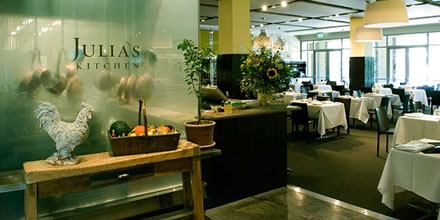
|
|
PRINT » |
|
|
E-MAIL THIS PAGE » |
|
|
CLOSE THIS WINDOW » |
News Headline October 16, 2008
Copia Struggles for Relevance
New director seeks creative route to solvency at Napa center

Now, seven years later, the institution seems to remain jinxed, and after many stabs at success, it is considering steps as drastic as filing for bankruptcy to escape its crushing debt.
Two weeks ago, Copia suddenly laid off 24 employees and announced "winter" hours, leaving it open only weekends and Fridays, and for special events. It was the latest blow after other disappointments, many stemming from its muddled original charter and failure to approach the projected attendance of 500,000 visitors per year. The total is closer to 150,000, even after Copia reduced its original admission fee from a lofty $12.50 to $5, then to free.
Mondavi bought and donated an underutilized plot of land nestled in the oxbow of the Napa River, and he donated $20 million in seed money. He insisted it not be named for him, as are the Mondavi Center for Wine and Food Science, which opened last week at the University of California, Davis, and the university's Mondavi Center for the Performing Arts.
Even so, Copia was commonly referred to as "The Mondavi Center" by locals, and other vintners were reluctant to make substantial donations to the center associated with a competitor.
Instead, the center borrowed $70 million to build its dramatic modern building. That structure is its albatross. Designed primarily as a museum, with large spaces that aren't useful for much but fair-like tastings or receptions, the building is short of things like hands-on kitchens, classrooms, production studios and other facilities that might make it more useful for educating consumers and professionals about food and wine, particularly in the age of the Internet.
The first executive director, Peggy Loar, was a museum professional from the East Coast who early made it clear that she didn't consider the local community her audience, alienating many people, including those most likely to have been fans. Although that later changed, the bad taste lingers.
More to the point, people who visited didn't understand what Copia was about. After gaining admission, there wasn't much to do besides visit exhibits about food and food-related art, unless they had signed up for classes that were held sporadically.
The restaurant, Julia's Kitchen didn't offer much reference to beloved Julia Child, an honorary trustee of the organization, and was considered both cold in ambience and needlessly fancy.
Loar was replaced by Arthur Jacobus, who sold off part of Copia's property to build a Westin hotel (which just opened), announced plans to sell Copia's south parking lot and gardens to raise more money, and restructured the debt, which ballooned to $78 million.
The organization has lost money every year until recently, not covering expenses or interest on its debt, much less paying back the principal. Since it opened, the center has lost between $4.2 million and $12 million per year, according to the 2007 annual report prepared by accountants Pisenti & Brinker and dated April 23, 2008.

For one thing, the building is clearly not worth $78 million, especially in today's troubled economy. McGuire is trying to eliminate Copia's debt one way or another. "I want to be debt-free by the end of the year, preferably without a bankruptcy, but all options are open," he said.
One possibility is for the mortgage holders to reclaim the building and lease out part to Copia--and part to other tenants. Unfortunately, 40,000 square feet of the open space isn't very useful.
McGuire wants to focus on content creation and delivery, and franchise the Copia concept out to profit-making groups like the Ritz Carlton project now going in across the river. He's already announced plans to open an expanded satellite in San Francisco next year--Copia already shares a space in San Francisco's Ghirardelli Square, where it gives classes and holds functions.
To create content and present it locally as well as over the Internet, Copia needs access to studio and performance space, which McGuire would like to add in underused upstairs ar eas. That space needn't be owned by Copia, he said. With all the Internet content startups and other video production people in Napa Valley, it could provide studio space for rent, too.
McGuire said he wants to keep the restaurant, upcoming wine bar and store, but he welcomes complementary tenants. He's talked to nonprofit groups that are potential tenants, such as the Napa Valley Museum, but they have their own financial problems.
One intriguing idea is a Napa civic and community center that could house city government, an art museum, Copia and perhaps other nonprofit groups like the Arts Council. The 250-seat auditorium and outdoor amphitheater would be great bonuses.
Meanwhile, Copia's website (copia.org) continues to evolve into a worthwhile destination rather than just a calendar, and now contains many videos on food and wine, with more to come.
In a few weeks, its e-commerce function will be turned on. McGuire said the website will emphasize wine sales, working with New Vine Logistics, which is also assisting Amazon.com and the Wall Street Journal to navigate the complex logistics of shipping wine.
On Oct. 11, the store at Copia reopened, completely reorganized to reflect what's also now being sold on the web, a marriage of Sur la Table and Smith & Hawken. It formerly featured unique gift items but little of practical appeal.
In addition, McGuire has hired popular young celebrity chef Tyler Florence to serve as dean of culinary studies, a post from which he'll head Copia's food programs, including overseeing Julia's Kitchen. Florence plans to focus more on the dishes and food Julia Child made famous, which should appeal to both tourists and locals. Already hosting TV series on the Food Network, he seems a natural to help build interest and visibility.
Unfortunately, Copia is now looking for Florence's wine counterpart. The dean of wine, Andrea Robinson, recently left after a relatively short association that started when Peter Marks left in the spring. Her goals were too similar to those of Copia: Robinson is making videos and selling wine, among other things, avenues that Copia is also pursuing.
Meanwhile, Copia continues to conduct business as usual--at least on weekends--and tourists are interested in visiting. The center and the complementary Oxbow Public Market, a small version of San Francisco's Ferry Plaza Market, have given many a reason to visit downtown Napa, and that's help the whole downtown blossom.
Copia also holds the promise of helping to educate consumers and members of the trade about wine, and building their appreciation. For that alone, its future should be of great interest to the wine community.
|
|
PRINT » |
|
|
E-MAIL THIS ARTICLE » |
|
|
CLOSE THIS WINDOW » |
